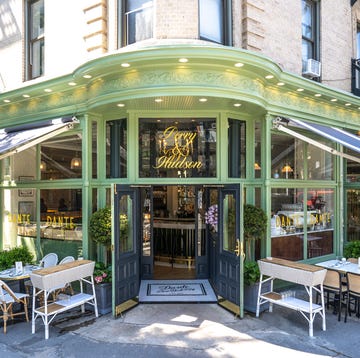When the restaurant Noma, a portmanteau of the Danish words nordisk (Nordic) and mad (food), opened in a former warehouse along the canals of Copenhagen’s Christianshavn neighborhood in 2003, “fine dining” meant white tablecloths and caviar. Then-25-year-old chef René Redzepi completely upended the concept. His belief that truly one-of-a-kind culinary experiences could be achieved in an unpretentious setting using natural, locally sourced ingredients set a new course for the farm-to-table movement. Noma topped the World’s 50 Best Restaurants list four times between 2010 and 2014 and became the foodie destination. And then it closed.
“We were starting to be limited by our success,” Redzepi says of his decision to shutter the restaurant and do pop-ups around the world. “Our entire team—60-some people, from the dishwasher to the CEO—traveled first to Tokyo, then Sydney, and finally Tulum,” recalls Redzepi. “At each new location, we found a new life, a new set of ingredients, and a new culture—completely new inspiration.”
It was these travels, particularly working on a spit-grilled vegetarian main course inspired by the Mexican specialty tacos al pastor, that eventually led to the celeriac shawarma that is on the menu of the new Noma, which opened in 2018 as a collection of glass-sided buildings on the outskirts of Freetown Christiania. This current iteration of the restaurant, which topped the World’s 50 Best Restaurants list again last year, in addition to earning a third Michelin star, takes an even more seasonal approach.
“I thought to myself, why are we trying to serve a tasting menu with a little bit of everything as opposed to what’s really good when it’s available?” says Redzepi. Noma now divides the year into three cycles, offering plant-based cuisine in the Scandinavian summer, serving wild game and foraged mushrooms when the season turns, and relying on the local fishermen’s haul in the winter months, as detailed in Noma 2.0 (Artisan Books), out next month. Below, Redzepi and Mette Brink Søberg, Noma’s head of R&D, discuss how the celeriac shawarma came to be.
METTE BRINK SØBERG: When we start developing a new seasonal menu, we discuss ingredients, flavors, concepts, and textures. Our test kitchen is situated in a greenhouse in between the main building and the dining room and guest lounge. Outside is our garden, designed by Piet Oudolf. Since the test kitchen is made from glass, we are very connected to the seasons and can pick flowers and leaves to use on the menu right at our doorstep.
RENÉ REDZEPI: We like to make lists of ingredients that we’d like to use and techniques that we’d like to employ. Creativity necessitates organization—through deadlines, lists, pictures as a frame of reference of what we’ve already created. We keep meticulous records of finished dishes, but all chefs working in the creative kitchen have their own records of what they have worked on.
MBS: In the beginning of the creative process, it is important to allow ourselves to spend time working on those ideas that might at first glance seem impossible or ridiculous, because even if they might not end up on the menu, they could lead to something that we would have never come across if we hadn’t sacrificed the time. Often the most innovative and original elements on the menu have many weeks and sometimes months of work behind them.
RR: The shawarma was one that took literally years to come together. We have been playing around with the idea of a “vegetable shawarma” for a very long time at Noma, from the old space into this new one. Different terrines of vegetables, seaweeds, fruits—trying to find the right combination of flavors and technique.
MBS: Root vegetables were most successful, particularly when sliced very thinly, and after many, many trials, we found that celeriac—the root of a celery plant, which is a staple vegetable in Denmark—was the best.
The shawarma is made by layering hundreds of slices, which are first slowly cooked in truffle juice mixed with browned butter and then brushed with a celery puree seasoned with truffle, a truffle puree, and a linseed fudge.
Once we reach the desired height, we cook the whole thing in an oven. We then slice it into portions and grill these slowly over very light coals to ensure a slow caramelization on both sides. During the cooking on the barbecue, the shawarma slices are also glazed with a truffle and linseed glaze, and we add sprigs of Douglas fir onto the coals to smoke it gently.
RR: Celeriac and truffle is a relatively classic combination—so we know it works—but when served in this way, it was something completely new to us. The richness from the linseed fudge and the smoke from the barbecue take the flavor to another level for me. We serve the shawarma with foraged herbs wrapped in steamed greens and currants brushed with elderflower oil to cut through the richness of this “vegetable meat,” as well as a caramelized apple wedge.
MBS: We have been working with Pometet, a research collection of fruit trees and shrubs run by the University of Copenhagen, which is just outside the city. They have pretty much all types of fruits and berries that grow here in Denmark—more than 750 varieties of apples and 200 varieties of strawberries—and let us pick.
We forage for aromatic herbs on nearby beaches such as Hundige Strand. Beach mustard has small pink flowers, which makes it easy to spot, and it has a really nice salty mustard flavor.
RR: There is a wealth of knowledge that each individual working in the test kitchen has; they are our most senior staff members. Each has particular specialties in their skill set, and their teamwork yields some of the most outstanding creations. Mette looks at a leaf and sees something completely different: a flower, a butterfly, or the base of something else beautiful and unique.




















